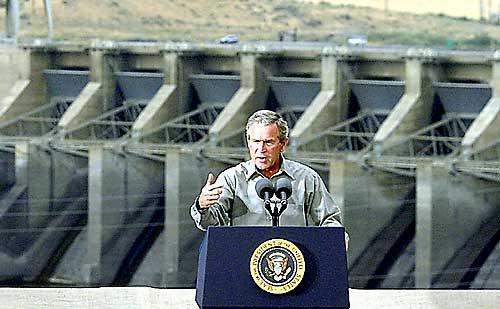forum
library
tutorial
contact

Appeals Court Hears Case Challenging
2014 Fish and Wildlife Program
by Laura Berg
NW Fishletter, June 5, 2017
|
the film forum library tutorial contact |

|
Appeals Court Hears Case Challenging
by Laura Berg
|
 The 9th U.S. Circuit Court of Appeals heard oral arguments in Seattle May 11 in a case that could overturn the Northwest Power and Conservation Council's 2014 Columbia Basin Fish and Wildlife Program.
The 9th U.S. Circuit Court of Appeals heard oral arguments in Seattle May 11 in a case that could overturn the Northwest Power and Conservation Council's 2014 Columbia Basin Fish and Wildlife Program.
The appeal [15-71482], brought by Northwest Resource Information Center, focused on the adequacy of the program's biological objectives and the role of the Council and that of fish agencies and tribes.
In January 2016, NRIC petitioned the court to vacate and replace the program because it fails to comply with the 1980 Pacific Northwest Electric Power Planning and Conservation Act.
The core issue, argued Todd True, an Earthjustice attorney representing NRIC, is that the Council has not determined if its program is meeting the "protect, mitigate and enhance" standard of the regional act.
The 2014 program doesn't include the necessary measureable biological objectives to inform that determination, he said during the May 11 hearing.
True said the few objectives that can be found in the program have been taken from the 2008-2014 BiOp on the Federal Columbia River Power System.
But, Judge Margaret McKeown interrupted during oral arguments to ask if BiOp objectives adopted as part of the program comply with the requirements of the both the Endangered Species Act and the regional act?
True conceded they could. The problem, he said, was the BiOp objectives are required to meet a different, lesser standard.
According to Council General Counsel John Shurts, the standards of the Northwest Power Act and ESA were different. "The power act's are not higher," he said.
Judge Randy Smith asked if adoption by the Council doesn't mean that the agency thinks the program has meet the power act standards?
That determination has to be explicitly articulated, True replied. The program, he said, offers no analyses as to whether the BiOp actions comply with the power act objectives to protect, mitigate and enhance the basin's fish and wildlife.
For his part, Shurts emphasized that in crafting the 2014 Fish and Wildlife Program the Council followed the power act's requirements as interpreted by the 9th Circuit. A 1994 9th Circuit opinion said the Council must defer, in particular, to fish agencies and tribes.
Shurts said the Council does not make "an independent biological judgment as to what is to be done to protect, mitigate and enhance fish and wildlife."
The Council, he said, "puts the recommended amendments together into a system and a program."
The Fish and Wildlife Program has been amended eighteen times since 1994, he said. The act requires the agency to update the program at least every five years.
That the Council sees its role as procedural, True said, is a problem. Accepting or rejecting recommendations only when there is consensus among the fish and wildlife agencies and tribes does not meet the Council's dual obligations to fish/wildlife and power, he said.
He reiterated that explanation is needed as to whether accepted recommendations meet power act standards.
McKeown seemed to say that at least in one example, the Council had not provided sufficient reasons for rejecting a proposal. Why, she asked, had the recommendation to improve juvenile survival by drawing down John Day Dam "ended up on the cutting room floor?"
Judge Carlos Bea opined that the John Day proposal came from the public and not the fish agencies or tribes, and thus lacked their support.
Smith offered that the proposal was from "the wrong recommender."
At several points during the hearing, Smith asked about recommendations from the public. The public includes conservation organizations like the NRIC and others that offered amendments to the fish program.
Returning to NRIC's contention there were few measureable biological objectives in the 2014 Fish and Wildlife Program other than BiOp objectives, Shurts said there were hundreds of such objectives, mentioning, among others, those contained in 60 subbasin plans.
Smith stated that the program "isn't just the ESA." It has other different measures, including a recommendation to investigate reintroducing fish above Grand Coulee Dam, he said.
No party objected to the BiOp measures being adopted, the judge noted. The Council didn't receive any alternatives to the BiOp passage measures to consider, Smith said.
"We're having trouble seeing what the Council should do," McKeown said.
NRIC is the sole petitioner in the case. The Northwest Power and Conservation Council is the respondent and the Public Power Council, Northwest RiverPartners, the Kootenai Tribe of Idaho, the Spokane Tribe of Indians and the states of Idaho and Montana are respondent-intervenors in the case. These respondents are also intervenors in National Wildlife Federation et al. v. National Marine Fisheries Service et al. [01-640], the FCRPS 2014 BiOp litigation.
learn more on topics covered in the film
see the video
read the script
learn the songs
discussion forum
